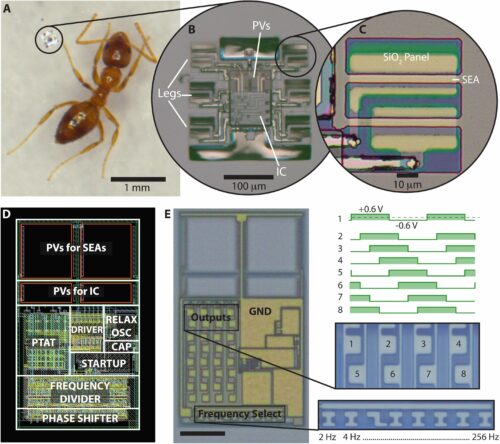Researchers from Cornell University have implemented electronic “brains” on solar-powered ant-sized smart microrobots that can walk autonomously and do not need to be controlled externally

Since the microrobots had to be controlled using ‘strings’ to receive the desired response from the robot. Hence, researchers developed an electronic brain that could enable microrobots to walk and provide desired responses autonomously without the need for any strings. The ‘brain’ in the new robots is a complementary metal-oxide-semiconductor CMOS clock circuit it consists of a thousand transistors, plus an array of diodes, resistors, and capacitors.
“One of the key parts that enable this is that we’re using microscale actuators that can be controlled by low voltages and currents,” said Cortese, who is CEO of OWiC Technologies, a company he founded with McEuen and Molnar to commercialize optical wireless integrated circuits for microsensors. “This is the first time that we showed that yes, you can integrate that directly into a CMOS process and have all of those legs be directly controlled by effectively one circuit.”
The integrated CMOS circuit produces a signal that generates a series of phase-shifted square wave frequencies that in turn set the gait of the robot. The robot legs are platinum-based actuators. Both the circuit and the legs are powered by photovoltaics. The final circuit arrived on 8-inch silicon-on-insulator wafers, Reynolds worked with the Cornell NanoScale Science and Technology Facility (CNF) to develop a complex process using 13 layers of photolithography to etch the brains lose into an aqueous solution and pattern the actuators to make the legs
“Eventually, the ability to communicate a command will allow us to give the robot instructions, and the internal brain will figure out how to carry them out,” Cohen said. “Then we’re having a conversation with the robot. The robot might tell us something about its environment, and then we might react by telling it, ‘OK, go over there and try to suss out what’s happening.’”
These microrobots are 10,000 times smaller than macroscale robots that feature onboard CMOS electronics, and they can walk at speeds faster than 10 micrometers per second. The fabrication of these microrobots is customizing foundry-built electronics that can enable other researchers to outfit microscopic robots with their apps from chemical detectors to photovoltaic “eyes” that help robots navigate by sensing changes in light. The team integrated their CMOS clock circuits into artificial cilia that were also built with platinum-based, electrically-powered actuators, to manipulate the movement of fluids.
Researchers visualize that in the future this CMOS electronics linked to robotic actuating limbs will help people design low-power microchips that can do all sorts of things
Click for the Published Research Paper and Video







